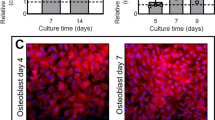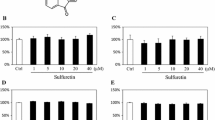Abstract
P2 receptors activated by ATP are expressed in the skeletal system. However, the role of P2 receptors in osteoblast differentiation remains unclear. Methods: Participation of P2 receptors in differentiation was investigated in the preosteoblast MC3T3-M1 cell line. Preosteoblasts were stimulated for 7 or 14 days in the presence of osteogenic medium containing ATP and its analogs, and then alkaline phosphatase (ALP) activity, gene expression analyses, and protein expression were assessed. Results: We observed that ATP and its analogs promoted increased ALP activity after 7 days of treatment. In contrast, these agonists promoted reductions in ALP activity after 14 days. Some antagonists, such as PPADS (P2 antagonist), MRS2179 (P2Y1 antagonist), MRS2578 (P2Y6 antagonist), and AZ11645373 (P2X7 antagonist) reduced the increases in ALP activity after 7 days. However, only AZ11645373 inhibited the reduction in ALP activity after 14 days. The expression of the P2Y2, P2Y6, P2X4, and P2X7 receptors was observed. Furthermore, treatment with ATP modulated the expression of P2 receptors, increasing P2X4 expression and reducing P2Y6 and P2X7 expression. Similar results were observed after 14 days. In addition, ATP treatment for 7 days increased the expression of transcription factors associated with osteoblast differentiation, such as Runx2, SP7, and Dix5, whereas SP7 and Dix5 expression was reduced at 14 days. These results suggest that P2 receptor activation modulates the differentiation of osteoblasts and is dependent upon the stage of differentiation. These results also suggest that several P2 receptors are involved in this process.




Similar content being viewed by others
References
Alvarenga, E. C., Rodrigues, R., Caricati-Neto, A., Silva-Filho, F. C., Paredes-Gamero, E. J., & Ferreira, A. T. (2010). Low-intensity pulsed ultrasound-dependent osteoblast proliferation occurs by via activation of the P2Y receptor: role of the P2Y1 receptor. Bone, 46(2), 355–362.
Rumney, R. M., Sunters, A., Reilly, G. C., & Gartland, A. (2012). Application of multiple forms of mechanical loading to human osteoblasts reveals increased ATP release in response to fluid flow in 3D cultures and differential regulation of immediate early genes. Journal of Biomechanics, 45(3), 549–554.
Romanello, M., Codognotto, A., Bicego, M., Pines, A., Tell, G., & D’andrea, P. (2005). Autocrine/paracrine stimulation of purinergic receptors in osteoblasts: contribution of vesicular ATP release. Biochem Biophys Res Commun, 331(4), 1429–1438.
Bowler, W. B., Buckley, K. A., Gartland, A., Hipskind, R. A., Bilbe, G., & Gallagher, J. A. (2001). Extracellular nucleotide signaling: a mechanism for integrating local and systemic responses in the activation of bone remodeling. Bone, 28(5), 507–512.
Burnstock, G. (2009). Purinergic signalling: past, present and future. Brazilian Journal of Medical and Biological Research, 42(1), 3–8.
Webb, T. E., Simon, J., Krishek, B. J., Bateson, A. N., Smart, T. G., King, B. F., et al. (1993). Cloning and functional expression of a brain G-protein-coupled ATP receptor. FEBS Letters, 324(2), 219–225.
Nicholas, R. A., Lazarowski, E. R., Watt, W. C., Li, Q., Boyer, J., & Harden, T. K. (1996). Pharmacological and second messenger signalling selectivities of cloned P2Y receptors. Journal of Autonomic Pharmacology, 16(6), 319–323.
Von Kugelgen, I., & Wetter, A. (2000). Molecular pharmacology of P2Y-receptors. Naunyn Schmiedebergs Arch Pharmacol, 362(4–5), 310–323.
Erb, L., Lustig, K. D., Sullivan, D. M., Turner, J. T., & Weisman, G. A. (1993). Functional expression and photoaffinity labeling of a cloned P2U purinergic receptor. Proc Natl Acad Sci U S A, 90(22), 10449–10453.
Communi, D., Parmentier, M., & Boeynaems, J. M. (1996). Cloning, functional expression and tissue distribution of the human P2Y6 receptor. Biochem Biophys Res Commun, 222(2), 303–308.
Troadec, J. D., Thirion, S., Nicaise, G., Lemos, J. R. & Dayanithi, G. (1998) ATP-evoked increases in [Ca2+]i and peptide release from rat isolated neurohypophysial terminals via a P2X2 purinoceptor. J Physiol, 511(Pt 1), 89–103.
Buell, G., Michel, A. D., Lewis, C., Collo, G., Humphrey, P. P., & Surprenant, A. (1996). P2X1 receptor activation in HL60 cells. Blood, 87(7), 2659–2664.
Gever, J. R., Cockayne, D. A., Dillon, M. P., Burnstock, G., & Ford, A. P. (2006). Pharmacology of P2X channels. Pflugers Archiv. European Journal of Physiology, 452(5), 513–537.
Wiley, J. S., Chen, J. R., Snook, M. B., & Jamieson, G. P. (1994). The P2Z-purinoceptor of human lymphocytes: actions of nucleotide agonists and irreversible inhibition by oxidized ATP. British Journal of Pharmacology, 112(3), 946–950.
Jin, J., Tomlinson, W., Kirk, I. P., Kim, Y. B., Humphries, R. G., & Kunapuli, S. P. (2001). The C6-2B glioma cell P2Y(AC) receptor is pharmacologically and molecularly identical to the platelet P2Y(12) receptor. British Journal of Pharmacology, 133(4), 521–528.
Communi, D., Gonzalez, N. S., Detheux, M., Brezillon, S., Lannoy, V., Parmentier, M., et al. (2001). Identification of a novel human ADP receptor coupled to G(i). Journal of Biological Chemistry, 276(44), 41479–41485.
Morrison, M. S., Turin, L., King, B. F., Burnstock, G. & Arnett, T. R. (1998) ATP is a potent stimulator of the activation and formation of rodent osteoclasts. J Physiol, 511(Pt 2), 495–500.
Bowler, W. B., Birch, M. A., Gallagher, J. A., & Bilbe, G. (1995). Identification and cloning of human P2U purinoceptor present in osteoclastoma, bone, and osteoblasts. Journal of Bone and Mineral Research, 10(7), 1137–1145.
Bowler, W. B., Littlewood-Evans, A., Bilbe, G., Gallagher, J. A., & Dixon, C. J. (1998). P2Y2 receptors are expressed by human osteoclasts of giant cell tumor but do not mediate ATP-induced bone resorption. Bone, 22(3), 195–200.
Nakamura, E., Uezono, Y., Narusawa, K., Shibuya, I., Oishi, Y., Tanaka, M., et al. (2000). ATP activates DNA synthesis by acting on P2X receptors in human osteoblast-like MG-63 cells. American Journal of Physiology. Cell Physiology, 279(2), C510–C519.
Hoebertz, A., Mahendran, S., Burnstock, G., & Arnett, T. R. (2002). ATP and UTP at low concentrations strongly inhibit bone formation by osteoblasts: a novel role for the P2Y2 receptor in bone remodeling. Journal of Cellular Biochemistry, 86(3), 413–419.
Orriss, I. R., Utting, J. C., Brandao-Burch, A., Colston, K., Grubb, B. R., Burnstock, G., et al. (2007). Extracellular nucleotides block bone mineralization in vitro: evidence for dual inhibitory mechanisms involving both P2Y2 receptors and pyrophosphate. Endocrinology, 148(9), 4208–4216.
Dixon, C. J., Bowler, W. B., Walsh, C. A., & Gallagher, J. A. (1997). Effects of extracellular nucleotides on single cells and populations of human osteoblasts: contribution of cell heterogeneity to relative potencies. British Journal of Pharmacology, 120(5), 777–780.
Hoebertz, A., Townsend-Nicholson, A., Glass, R., Burnstock, G., & Arnett, T. R. (2000). Expression of P2 receptors in bone and cultured bone cells. Bone, 27(4), 503–510.
Alqallaf, S. M., Evans, B. A., & Kidd, E. J. (2009). Atypical P2X receptor pharmacology in two human osteoblast-like cell lines. British Journal of Pharmacology, 156(7), 1124–1135.
Orriss, I. R., Key, M. L., Brandao-Burch, A., Patel, J. J., Burnstock, G., & Arnett, T. R. (2012). The regulation of osteoblast function and bone mineralisation by extracellular nucleotides: The role of p2x receptors. Bone, 51(3), 389–400.
Orriss, I. R., Knight, G. E., Ranasinghe, S., Burnstock, G., & Arnett, T. R. (2006). Osteoblast responses to nucleotides increase during differentiation. Bone, 39(2), 300–309.
Chaves Neto, A. H., Yano, C. L., Paredes-Gamero, E. J., Machado, D., Justo, G. Z., Peppelenbosch, M. P., et al. (2010). Riboflavin and photoproducts in MC3T3-E1 differentiation. Toxicology in Vitro, 24(7), 1911–1919.
Siggelkow, H., Rebenstorff, K., Kurre, W., Niedhart, C., Engel, I., Schulz, H., et al. (1999). Development of the osteoblast phenotype in primary human osteoblasts in culture: comparison with rat calvarial cells in osteoblast differentiation. Journal of Cellular Biochemistry, 75(1), 22–35.
Korcok, J., Raimundo, L. N., Ke, H. Z., Sims, S. M., & Dixon, S. J. (2004). Extracellular nucleotides act through P2X7 receptors to activate NF-kappaB in osteoclasts. Journal of Bone and Mineral Research, 19(4), 642–651.
Virginio, C., North, R. A. & Surprenant, A. (1998) Calcium permeability and block at homomeric and heteromeric P2X2 and P2X3 receptors, and P2X receptors in rat nodose neurones. J Physiol, 510(Pt 1), 27–35.
Vassort, G. (2001). Adenosine 5′-triphosphate: a P2-purinergic agonist in the myocardium. Physiological Reviews, 81(2), 767–806.
Abbracchio, M. P., & Ceruti, S. (2007). P1 receptors and cytokine secretion. Purinergic Signal, 3(1–2), 13–25.
Costa, M. A., Barbosa, A., Neto, E., Sa-E-Sousa, A., Freitas, R., Neves, J. M., et al. (2011). On the role of subtype selective adenosine receptor agonists during proliferation and osteogenic differentiation of human primary bone marrow stromal cells. Journal of Cellular Physiology, 226(5), 1353–1366.
Acknowledgments
This work was supported by INFAR/UNIFESP Confocal and Flow Cytometry Facility, “Coordenação de Aperfeiçoamento de Pessoal de Nível Superior (CAPES)”, “Conselho nacional de desenvolvimento científico e Tecnológico” (CNPq) and “Fundação de Amparo à Pesquisa do Estado de São Paulo” (FAPESP). RR-R was supported by a master fellowship from the FAPESP (2009/02775-4).
Conflict of interest
All of the authors state that they have no conflicts of interest.
Author information
Authors and Affiliations
Corresponding author
Electronic Supplementary Material
Below is the link to the electronic supplementary material.
Rights and permissions
About this article
Cite this article
Rodrigues-Ribeiro, R., Alvarenga, É.C., Calio, M.L. et al. Dual Role of P2 Receptors during Osteoblast Differentiation. Cell Biochem Biophys 71, 1225–1233 (2015). https://doi.org/10.1007/s12013-014-0332-7
Published:
Issue Date:
DOI: https://doi.org/10.1007/s12013-014-0332-7




